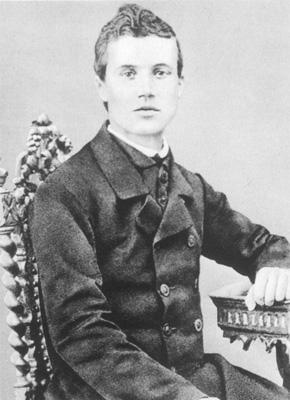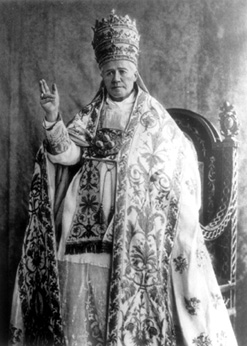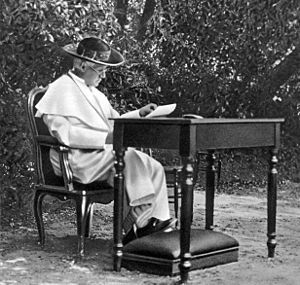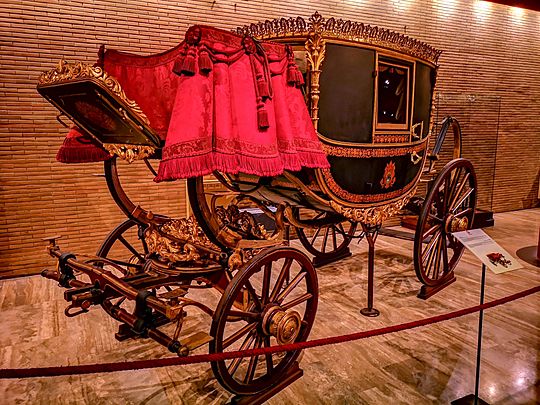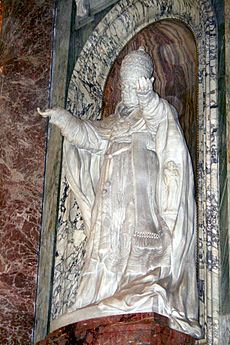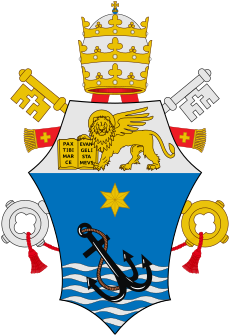Pope Pius X facts for kids
Quick facts for kids Pope Saint Pius X |
|
|---|---|
| Bishop of Rome | |

Portrait by Ernest Walter Histed, c. 1914
|
|
| Church | Catholic Church |
| Papacy began | 4 August 1903 |
| Papacy ended | 20 August 1914 |
| Predecessor | Leo XIII |
| Successor | Benedict XV |
| Orders | |
| Ordination | 18 September 1858 |
| Consecration | 16 November 1884 by Lucido Maria Parocchi |
| Created Cardinal | 12 June 1893 |
| Personal details | |
| Birth name | Giuseppe Melchiorre Sarto |
| Born | 2 June 1835 Riese, Treviso, Lombardy–Venetia, Austrian Empire |
| Died | 20 August 1914 (aged 79) Apostolic Palace, Rome, Kingdom of Italy |
| Previous post |
|
| Motto | Instaurare Omnia in Christo (To restore all things in Christ) |
| Signature | |
| Coat of arms |  |
| Sainthood | |
| Feast day | 21 August 3 September (General Roman Calendar 1955–1969) |
| Venerated in | Catholic Church |
| Beatified | 3 June 1951 Saint Peter's Basilica, Vatican City by Pius XII |
| Canonized | 29 May 1954 Saint Peter's Basilica, Vatican City by Pius XII |
| Patronage | Society of Saint Pius X Archdiocese of Atlanta, Georgia; Diocese of Des Moines, Iowa; First Communicants; Diocese of Great Falls-Billings, Montana; Archdiocese of Kottayam, India; pilgrims; Santa Luċija, Malta; Diocese of Springfield-Cape Girardeau, Missouri; Archdiocese of Zamboanga, Philippines; emigrants from Treviso; Patriarchate of Venice; Catechists; St. Pius X Seminary (Dubuque, Iowa) |
| Other Popes named Pius | |
Pope Pius X (born Giuseppe Melchiorre Sarto; 2 June 1835 – 20 August 1914) led the Catholic Church as Pope from August 1903 until his death in August 1914. He is remembered for his strong beliefs and for making important changes to Church practices and laws. He is honored as a saint in the Catholic Church.
Pius X was very devoted to the Blessed Virgin Mary. His main goal as Pope was to "restore all things in Christ." He encouraged people to receive Holy Communion often and even lowered the age for First Communion to seven years old. This was a big change that lasted.
He believed that the teachings of Thomas Aquinas were very important for Catholic schools. He also strongly disagreed with new ideas, called "modernism," which he felt went against traditional Catholic beliefs.
Pius X was known for living a simple life and for his kindness. He often gave sermons, which was unusual for popes at that time. After a big earthquake in 1908, he opened the Apostolic Palace to help people who had lost their homes. He refused to give special favors to his family, and they chose to live simply near Rome. He also updated how the Roman Curia (the Church's administration) worked.
After he died, many people felt he was a very holy person. He was declared "blessed" in 1951 and a "saint" in 1954 by Pope Pius XII. There is a statue of him in Saint Peter's Basilica, and his hometown was renamed Riese Pio X in his honor.
Contents
Early Life and Church Service
Giuseppe Melchiorre Sarto was born in Riese, Italy, in 1835. He was the second of ten children. His father, Giovanni Battista Sarto, was a village postman, and his mother was Margherita Sanson. Even though his family was poor, they believed in the importance of education. Giuseppe walked about 6 kilometers (4 miles) to school every day.
Giuseppe had three brothers and six sisters. As Pope, he made sure his family did not get any special treatment. His brother remained a postal worker, his favorite nephew stayed a village priest, and his three single sisters lived simply in Rome, just like other ordinary people.
Giuseppe, often called "Beppi," was a lively child. He was an excellent student and always did his homework before playing. In the evenings, he would pray for ten minutes before going home. He also served as an altar boy. By age ten, he had finished elementary school and studied Latin with a local priest. After that, he walked four miles to a larger school in Castelfranco Veneto. He would attend Mass before breakfast and his long walk to school. He often carried his shoes to make them last longer. Other children sometimes teased him for his simple lunches and old clothes, but he never complained.
In 1850, he received a scholarship from the Diocese of Treviso to study at the Seminary of Padua. There, he excelled in his studies of classical subjects, philosophy, and theology.
On 18 September 1858, Giuseppe Sarto became a priest. He was assigned as a chaplain in Tombolo. While there, he learned more about theology and Church law. He also helped the sick during a cholera outbreak in the early 1870s. People in Tombolo admired his holiness so much that some called him "Don Santo" (Father Saint).
In 1867, he became the main priest of Salzano. He helped fix the church and expand the hospital there, often using his own money and hard work. He also became a canon of the cathedral and a chancellor for the Diocese of Treviso. He held other roles, like spiritual director and rector of the Treviso seminary. As chancellor, he made it possible for public school students to receive religious lessons. He always tried to find ways to teach religious instruction to young people in both cities and the countryside.
Once, a large stack of hay caught fire near a house. When Sarto arrived, he told the worried people, "Don't be afraid, the fire will be put out and your house will be saved!" At that moment, the flames changed direction, leaving the house untouched. Despite his many duties, Sarto often took evening walks with children who were preparing for their First Communion.
In 1879, after Bishop Federico Maria Zinelli died, Sarto was chosen to lead the diocese temporarily until a new bishop was appointed.
After 1880, Sarto taught theology at the seminary in Treviso. On 10 November 1884, Pope Leo XIII appointed him bishop of Mantua. He was made a bishop six days later in Rome. Sarto needed special permission from Pope Leo XIII to become a bishop because he did not have a doctorate degree. He was the last pope without a doctorate until Pope Francis.
When Sarto returned to his hometown after becoming a bishop, he immediately visited his mother. She kissed his bishop's ring and then showed him her own wedding ring, saying, "But you would not have this fine ring, son, if I did not have this."
Becoming a Cardinal and Patriarch
Pope Leo XIII made Giuseppe Sarto a cardinal on 12 June 1893. A few days later, on 15 June, Pope Leo XIII gave him his cardinal's red hat and assigned him to the church of San Bernardo alle Terme. He was also appointed Patriarch of Venice.
This appointment caused some problems because the Italian government believed it had the right to choose the Patriarch of Venice. This was because the previous ruler, the Emperor of Austria, had held that power. Relations between the Church and the Italian government were already difficult since the Church's lands were taken in 1870. Eventually, Sarto was allowed to become Patriarch in 1894. When he was named a cardinal, Sarto told a local newspaper that he felt "anxious, terrified and humiliated."
Before leaving for Venice, he visited his mother again. She was very emotional and tearfully asked him for a "last blessing," feeling it would be their final meeting. When he arrived in Venice, he was formally welcomed on 24 November 1894.
As cardinal-patriarch, Sarto focused on social work and strengthening local Church banks, rather than politics. He told the people of Venice that when it came to the Pope, there should be "only obedience."
In April 1903, Pope Leo XIII reportedly said that Sarto would be his successor. By the time of the papal election, Sarto was known as one of the most important preachers in the Church, even though he was not famous worldwide. As a cardinal, Sarto was part of important Church groups that dealt with bishops, religious ceremonies, and special blessings.
The Papal Election of 1903
Pope Leo XIII died on 20 July 1903. At the end of that month, the conclave (the meeting where cardinals elect a new Pope) began. Before the conclave, Sarto reportedly said he would rather die than become Pope. When asked if he spoke French, which was considered important for a Pope, Sarto replied in Latin, "I'm afraid I do not speak French." He then added, "Thank God! I have no desire to be pope."
Many historians believe that Cardinal Mariano Rampolla, the late Pope's secretary, was the favorite to win. In the first vote, Rampolla received 24 votes, while Sarto received 5. In the second vote, both Rampolla and Sarto gained more votes. The next day, it seemed Rampolla would be elected. However, a Polish cardinal, Jan Puzyna de Kosielsko, announced that Emperor Franz Joseph of Austria-Hungary was against Rampolla's election. This was called a jus exclusivae or "veto." Many cardinals protested this interference.
However, the third vote had already started. Sarto gained more support, with 21 votes. The fourth vote showed Rampolla with 30 votes and Sarto with 24. It became clear that the cardinals were leaning towards Sarto.
The next morning, the fifth vote gave Rampolla 10 votes and Sarto 50. So, on 4 August 1903, Sarto was elected Pope. This was the last time a Catholic monarch tried to veto a papal election.
At first, Sarto reportedly refused the role, feeling he was not worthy. He was very upset by the Austrian-Hungarian veto. He promised to get rid of these veto powers and to excommunicate (remove from the Church) anyone who tried to use such a veto in the future. The cardinals asked him to think again. After praying deeply, he accepted. Cardinal Luigi Macchi announced Sarto's election around 12:10 PM.
Sarto chose the name Pius X to honor previous Popes with that name, especially Pope Pius IX (1846–1878), who had also faced challenges. He explained, "As I shall suffer, I shall take the name of those Popes who also suffered." Pius X's official crowning ceremony took place on 9 August 1903. As Pope, he became the head of several important Church departments.
Pope Pius X's Time as Pope
| Papal styles of Pope Pius X |
|
|---|---|
 |
|
| Reference style | His Holiness |
| Spoken style | Your Holiness |
| Religious style | Holy Father |
| Posthumous style | Saint |
Pope Pius X's time as Pope was known for his traditional beliefs and for changes he made to Church ceremonies and laws. His main goal, which became his motto, was Instaurare Omnia in Christo, meaning "to restore all things in Christ." In his first official letter as Pope (E supremi apostolatus, 4 October 1903), he said his main policy was: "We champion the authority of God. His authority and Commandments should be recognized, deferred to, and respected."
Showing his simple background, he wore a cross made of gilded metal on the day he was crowned. When his assistants were shocked, he said he always wore it and had no other. He was known for making papal ceremonies less grand. He also stopped the tradition of the Pope eating alone, which had been the custom since the time of Pope Urban VIII. Instead, he invited friends to eat with him.
When important people in Rome criticized him for not making his sisters, who were from a peasant family, papal countesses, he replied: "I have made them sisters of the Pope; what more can I do for them?"
He was known for being very friendly with children. He carried candy in his pockets for children in the streets of Mantua and Venice and taught them about their faith. During meetings with visitors, he would gather children around him and talk about things they liked. His weekly lessons for children in the Vatican always had a special place for them. He also decided that every parish should have a group to teach Christian lessons, partly to help children learn about their faith.
He was known for his humility and simplicity. He said he had not changed personally, except for wearing a white robe. His assistants often had to remind him not to wipe his pen on his white robe, as he used to do on his black one, which hid stains. The new Pope's daily schedule was quite similar each day. He woke up at 4:00 AM and celebrated Mass at 6:00 AM. He was at his desk by 8:00 AM for private meetings. On his desk were statues of John Vianney and Joan of Arc, whom he declared blessed during his papacy. At noon, he met with pilgrims, then had lunch at 1:00 PM with his secretaries or guests. After a short rest, Pius X returned to work before dinner at 9:00 PM and more work before sleeping.
Church Changes and Beliefs
Restoring All in Christ and Mary
In his 1904 letter Ad diem illum, Pope Pius X explained that Mary helps in "restoring everything in Christ."
During his time as Pope, many famous images of Mary were given a special honor called a canonical coronation. These included images like Our Lady of Aparecida and Our Lady of the Pillar.
Tra le sollecitudini and Gregorian Chant
Within three months of becoming Pope, Pius X released a special document called Tra le sollecitudini. For a long time, classical and Baroque music were preferred in churches over Gregorian chant. The Pope announced that the Church should return to older musical styles. He chose Joseph Pothier to oversee new editions of chant, which led to the official use of the Solesmes version of Gregorian chant.
Changes to Church Services and Communion
Pius X worked to make people more devoted to their faith, especially through the Breviary (daily prayers for priests) and the Mass. He made many changes to the Breviary.
Besides bringing back Gregorian Chant, he put a new focus on the Eucharist (Holy Communion). He said, "Holy Communion is the shortest and safest way to Heaven." Because of this, he encouraged people to receive Holy Communion often. He also allowed children to receive their First Communion at the "age of discretion" (around seven years old), though he did not allow the very old practice of giving Communion to babies. He also stressed the importance of going to Confession often so that Holy Communion would be received worthily. Pius X's strong belief in the Eucharist earned him the name "Pope of the Blessed Sacrament."
In 1910, he issued a decree called Quam singulari, which changed the age for receiving Communion from 12 to 7 years old. The Pope lowered the age because he wanted children to remember this important event and encourage their parents to be more religious. Some people did not like this change, fearing that parents would take their children out of Catholic schools earlier. Pius X even personally gave First Communion to a four-year-old boy who showed he understood the sacrament well. When people criticized him for lowering the age, he simply quoted Jesus, "let the little children come to me."
Pius X said in his 1903 document Tra le sollecitudini: "The primary and indispensable source of the true Christian spirit is participation in the most holy mysteries and in the public, official prayer of the Church."
He also tried to change papal ceremonies to highlight their religious meaning. For example, when he entered his first public meeting to create cardinals in November 1903, he was not carried above the crowds on the sedia gestatoria (a special chair) as was traditional. He walked in, almost hidden by the guards, to show humility.
Against Modernism
Pope Leo XIII had tried to bring back the teachings of Thomas Aquinas, which combined reason and faith. Under Pius X, these teachings became the main way of thinking in Catholic theology.
Most famously, Pius X strongly spoke out against a theological movement he called 'Modernism'. He saw it as a dangerous idea that threatened the Catholic faith. This movement was linked to some Catholic scholars who questioned traditional beliefs, like whether God acts directly in human affairs, or if some parts of the Bible should be understood metaphorically rather than literally. These ideas, from a traditional viewpoint, could lead to people believing that truth is relative or that we can't really know things for sure. Modernism tried to mix modern philosophies with Catholic theology. Modernists argued that Church beliefs had changed over time and would continue to change.
Those against Modernism believed these ideas went against the core teachings and traditions of the Catholic Church. In a decree called Lamentabili sane exitu ("A Lamentable Departure Indeed") on 3 July 1907, Pius X officially condemned 65 ideas, mostly from the works of a scholar named Alfred Loisy. These ideas were about the Church, God's revelations, how to understand the Bible, the sacraments, and the divinity of Christ. After this, he released an official letter called Pascendi dominici gregis ("Feeding the Lord's Flock"), which described Modernism as the "synthesis of all heresies" (meaning it combined all wrong beliefs). Following these, Pius X ordered all priests to take an Anti-Modernist oath, Sacrorum antistitum.
Pius X's strong stand against Modernism caused some problems within the Church. Although only about 40 priests refused to take the oath, Catholic studies that leaned towards Modernism were greatly discouraged. Theologians who wanted to explore ideas related to secularism or relativism had to stop, or they would face conflict with the Pope and possibly even be removed from the Church.
Pius X was very firm about Modernists. He said about those who suggested being kinder to them: "They want them to be treated with oil, soap and caresses. But they should be beaten with fists." He also started a secret group called the Sodalitium Pianum, which was an anti-Modernist network of informants. This group was criticized for accusing people of heresy with very little proof. This campaign was run by Umberto Benigni, who spread anti-Modernist messages and collected information on those he considered "guilty." In Benigni's secret code, Pius X was known as Mama.

Catechism of Saint Pius X
In 1905, Pius X wrote a letter called Acerbo nimis. In it, he ordered that a group for Christian teaching (catechism class) be set up in every parish around the world.
The Catechism of Pius X was his idea for a simple, clear, and short catechism for everyone to use. It was used in Rome and parts of Italy, but not for the whole Church. This catechism was known for being "simple to explain and deep in content." Pius X praised it as a good way to teach religion in his 1905 letter Acerbo nimis.
The Catechism of Saint Pius X was published in Italian in 1908. An English translation is over 115 pages long.
In 2003, Cardinal Joseph Ratzinger was asked if the nearly 100-year-old Catechism of Saint Pius X was still useful. He said: "The faith as such is always the same. Hence the Catechism of Saint Pius X always preserves its value. Whereas ways of transmitting the contents of the faith can change instead. And hence one may wonder whether the Catechism of Saint Pius X can in that sense still be considered valid today."
Changes to Church Law
Church law used to be different in various regions. On 19 March 1904, Pope Pius X created a group of cardinals to write a single set of laws for the whole Church. Two future Popes, Giacomo della Chiesa (who became Pope Benedict XV) and Eugenio Pacelli (who became Pope Pius XII), worked on this group. This first Code of Canon Law was officially put into effect by Benedict XV on 27 May 1917. It was used until 1983.
Changes to Church Management
Pius X changed how the Roman Curia (the Church's main administration) worked with a document called Sapienti Consilio (29 June 1908). He also set new rules for bishops to oversee seminaries (schools for priests) in his letter Pieni l'animo. He created regional seminaries and introduced a new study plan for them. He also prevented clergy from managing social organizations.
Church Policies Towards Governments

Pius X took a firmer approach than his predecessor, Leo XIII, towards governments. He appointed Rafael Merry del Val as his Cardinal Secretary of State. When the French president Émile Loubet visited the Italian king Victor Emmanuel III, Pius X refused to meet him. This was because the Pope still did not accept Italy's control over the former papal lands. This led to a break in relations with France and to the 1905 Law of Separation between church and state in France. With this law, the Church lost government funding in France. The Pope spoke out against this law and removed two French bishops for accepting it. Eventually, France expelled the Jesuits and ended diplomatic ties with the Vatican.
The Pope took a similar stand with governments in Portugal, Ireland, Poland, and Ethiopia. His strong stance against dealing with the Italian government upset some countries. In Ireland, Protestants worried that if Ireland gained self-rule, the Catholic majority would be too influenced by the Pope's strict views.
In 1908, a papal decree called Ne Temere made mixed marriages more complicated. Marriages not performed by a Catholic priest were considered legal but not valid as a sacrament. This worried some Protestants, who feared the Church would tell couples married in a Protestant church or by civil service to separate. Priests could refuse mixed marriages or set conditions, often requiring children to be raised Catholic. This decree caused a lot of debate in Ireland, especially with its large Protestant population.
As governments challenged the Church, Pius X became even more determined. He stopped the Opera dei Congressi, which organized Catholic groups in Italy. He also condemned Le Sillon, a French social movement that tried to combine Church teachings with liberal political ideas. He also opposed labor unions that were not exclusively Catholic.
Pius X partly allowed Italian Catholics to vote again, after a previous ban, but he never officially recognized the Italian government.
Relations with the Kingdom of Italy
At first, Pius X continued the policy of being a "prisoner in the Vatican" (meaning he stayed within the Vatican walls and did not recognize the Italian government). However, as socialism grew, he began to relax the rule that stopped Catholics from voting. In 1905, he allowed bishops to give permission for their church members to vote when it was for "the supreme good of society."
Relations with Poland and Russia
Under Pius X, the difficult situation for Polish Catholics in Russia did not get better. Although the Russian ruler Nicholas II of Russia promised religious freedom for the Catholic Church in 1903 and a constitution in 1905, the Russian Orthodox Church felt threatened. They insisted on strict interpretations of the rules. Papal decrees were not allowed, and contact with the Vatican remained forbidden.
Activities for the United States
In 1908, Pius X recognized the growth of the American Church by removing the United States from its "missionary status." Fifteen new dioceses (church regions) were created in the U.S. during his time as Pope, and he named two American cardinals. He was very popular among American Catholics, who often saw him as an ordinary man from a poor family who became Pope.
In 1910, the Pope refused to meet with former U.S. Vice-President Charles W. Fairbanks, who had spoken at a Methodist meeting in Rome. He also refused to meet with former President Theodore Roosevelt, who planned to speak at the same meeting.
On 8 July 1914, Pope Pius X approved a request to place the Immaculate Conception as the patron of the construction site for the National Shrine of the Immaculate Conception in Washington, DC.
Miracles During the Pope's Life
Besides stories of miracles after his death, there are also stories of miracles performed by Pope Pius X during his lifetime.
Once, during a meeting, Pius X was holding a paralyzed child. The child suddenly wriggled free from his arms and ran around the room. Another time, a couple who had confessed to him when he was a bishop had a two-year-old child with meningitis. They wrote to the Pope, and Pius X wrote back, telling them to hope and pray. Two days later, the child was cured.
Cardinal Ernesto Ruffini (who later became Archbishop of Palermo) visited the Pope after being diagnosed with tuberculosis. The Pope told him to go back to the seminary and that he would be fine. Ruffini shared this story with those investigating the Pope's path to sainthood.
Once, a man with a paralyzed arm begged Pius X for help. The Pope took his arm and simply said, "have confidence in the Lord... only have faith and the Lord will heal you." At that moment, the man could move his arm and joyfully called out to the Pope. Pius X simply put a finger to his lips, telling the man to keep it quiet. Another time, an Irish girl covered in sores was brought to the Pope by her mother. When Pius X saw her, he placed his hand on her head, and the sores completely disappeared. In another case, a Roman schoolgirl had a serious foot disease that made her crippled since she was one year old. She managed to get one of the Pope's socks and was told she would be healed if she wore it. The moment she put the sock on, her diseased foot was instantly healed. When Pius X heard about this, he laughed and said, "What a joke! I wear my own socks every day and still I suffer from constant pain in my feet!"
Other Activities
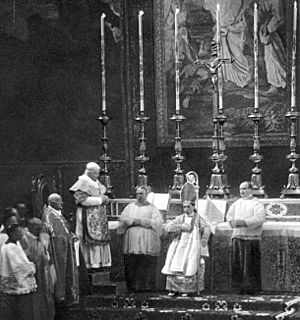
Pius X also reorganized the Roman Curia. He worked to improve the education of priests and reformed seminaries and their study plans. In 1904, Pope Pius X allowed seminary students to attend the College of St. Thomas. He made the college a "Pontifical" institution on 2 May 1906, meaning its degrees were equal to those of other pontifical universities worldwide. In 1908, the college became the Collegium Pontificium Internationale Angelicum, which later became the Pontifical University of Saint Thomas Aquinas, Angelicum in 1963.
Pius X published 16 encyclicals (official letters). One of them, Vehementer nos (11 February 1906), condemned the 1905 French law on the separation of the State and the Church. Pius X also confirmed the idea of Limbo in Catholic theology in his 1905 Catechism. He said that unbaptized people "do not have the joy of God but neither do they suffer... they do not deserve Paradise, but neither do they deserve Hell or Purgatory." On 23 November 1903, Pius X issued a rule that banned women from singing in church choirs.
In the Prophecy of St. Malachy, a collection of 112 prophecies about popes, Pius X is called Ignis Ardens or "Burning Fire."
Declared the Tango "Off-limit"
In November 1913, Pope Pius X said that tango dancing was immoral and not allowed for Catholics. Later, in January 1914, when tango remained very popular, Pope Pius X tried a different approach. He joked that tango was "one of the dullest things imaginable" and suggested people dance the furlana, a Venetian dance, instead.
Canonizations and Beatifications
Pius X declared 131 people "blessed" (beatified) and four people "saints" (canonized). Those he beatified included John Bosco (1907) and Joan of Arc (1909). Those he canonized were Alexander Sauli (1904), Gerard Majella (1904), Clement Mary Hofbauer (1909), and Joseph Oriol (1909).
In 1908, Pope Pius X named John Chrysostom a patron saint of preachers.
Creating Cardinals
Pius X created 50 cardinals in seven ceremonies during his time as Pope. These included important Church figures like Désiré-Joseph Mercier (1907) and Pietro Gasparri (1907). In 1911, he increased the number of American cardinals because the United States was growing. He also named one cardinal secretly (in pectore) in 1911, whose name he revealed in 1914. Pius X also named Giacomo della Chiesa, who would become the next Pope, as a cardinal.
Among the cardinals he named were the first from Brazil and the first from the Netherlands since 1523. The ceremony in 1911 had the largest number of cardinals appointed at one time in about a century.
Death and Burial
In 1913, Pope Pius X had a heart attack and was in poor health afterward. In 1914, he became very ill on 15 August. His condition worsened due to the start of World War I (1914–1918), which reportedly made the 79-year-old Pope very sad. He died on Thursday, 20 August 1914, just hours after the death of Jesuit leader Franz Xavier Wernz, and on the same day German forces marched into Brussels.
While the Pope's condition was serious, alarming signs did not appear until 19 August. Pius X was in and out of consciousness most of that day. He received the Last Rites. An old lung infection he had suffered from before returned, making his health decline faster.
Pius X died at 1:20 AM on 20 August 1914. Moments before he died, in a clear moment, Pius X reportedly said: "Now I begin to think the end is approaching. The Almighty in His inexhaustible goodness wishes to spare me the horrors which Europe is undergoing." His sister, Anna, was praying by his bedside when he passed away. The Pope's last action was to kiss the small crucifix he held in his hands around 1:15 AM.
Pius X was buried in a simple tomb in the crypt below Saint Peter's Basilica. His body was displayed on 21 August in red papal robes and then buried after a Mass. His original tombstone read: "Pope Pius X, poor and yet rich, gentle and humble of heart, unconquerable champion of the Catholic Faith, whose constant endeavor it was to renew all things in Christ." Popes used to have their organs removed to help with embalming, but Pius X specifically forbade this for his burial, and later popes have followed this tradition. Pius X's tomb is near the tombs of Pope John XXIII and Pope John Paul II.
Exhumation
On 19 May 1944, Pius X's body was dug up for examination as part of the process to declare him blessed. His remains were found to be remarkably well preserved. In 1959, with permission from Pope John XXIII, his remains were sent to Venice. Before the remains were taken to Venice by train on 11 April, Pope John XXIII led a small prayer service. The body was displayed for people to see at the Basilica of Saint Mark for one month (12 April–10 May) before being returned to his original resting place.
Becoming a Saint
| Pope Saint Pius X | |
|---|---|

Pius X in 1903.
|
|
| Pope, Confessor | |
| Born | Giuseppe Melchiorre Sarto 2 June 1835 Riese, Treviso, Italy |
| Died | 20 August 1914 (aged 79) Apostolic Palace, Rome, Kingdom of Italy |
| Venerated in | Catholic Church |
| Beatified | 3 June 1951, Saint Peter's Basilica, Vatican City by Pope Pius XII |
| Canonized | 29 May 1954, Saint Peter's Basilica, Vatican City by Pope Pius XII |
| Feast | 21 August 3 September (General Roman Calendar 1955–1969) |
| Patronage | Archdiocese of Atlanta, Georgia; diocese of Des Moines, Iowa; first communicants; Diocese of Great Falls-Billings, Montana; archdiocese of Kottayam, India; pilgrims; Santa Luċija, Malta; Diocese of Springfield-Cape Girardeau, Missouri; Archdiocese of Zamboanga, Philippines; emigrants from Treviso; Patriarchate of Venice; St. Pius X Seminary (Dubuque, Iowa) |
Although Pius X became a saint in 1954, the process started right after his death. People felt he was a "great Saint and a great Pope." To allow many visitors to see his tomb, a small metal cross was placed on the basilica floor above it. Masses were held near his tomb until 1930.
People continued to admire Pius X between the two world wars. On 14 February 1923, to mark 20 years since he became Pope, the first steps to make him a saint began. A monument was built in his memory in St. Peter's Basilica. On 19 August 1939, Pope Pius XII praised Pius X. On 12 February 1943, Pius X was declared to have shown "heroic virtues," earning him the title "Venerable."
On 19 May 1944, Pius X's coffin was opened for an official examination. The examiners found his body remarkably well preserved, even though he had died 30 years earlier and had not been embalmed. After the examination, Pius XII gave Pius X the title of "Venerable Servant of God." His body was displayed for 45 days before being placed back in his tomb.
After this, the process to declare him "blessed" began. Church officials investigated miracles that happened through Pius X's prayers. They recognized two miracles. The first involved Marie-Françoise Deperras, a nun with bone cancer, who was cured in 1928 when a relic of Pius X was placed on her chest. The second involved Benedetta De Maria, a nun with cancer, who was cured in 1938 after touching a statue of Pius X.
Pope Pius XII officially approved these two miracles on 11 February 1951. On 4 March, Pius XII declared that the Church could proceed with making Pius X "blessed." He was declared "blessed" on 3 June 1951 at St. Peter's Basilica, in front of many cardinals, bishops, and 100,000 faithful. During this ceremony, Pius XII called Pius X the "Pope of the Eucharist" because he encouraged children to receive Communion.
After he was declared blessed, on 17 February 1952, Pius X's body was moved from his tomb to the Vatican basilica. It was placed under the altar of the Chapel of the Presentation, inside a glass and bronze case for people to see.
On 29 May 1954, less than three years after being declared blessed, Pius X was made a saint. This happened after two more miracles were recognized. The first involved Francesco Belsami, a lawyer from Naples who had a lung infection and was cured after placing a picture of Pope Pius X on his chest. The second involved Sister Maria Ludovica Scorcia, a nun with a serious nerve virus, who was completely cured after praying for Pius X's help. The ceremony to make him a saint was led by Pius XII at Saint Peter's Basilica, with about 800,000 people attending. Pius X was the first Pope to be made a saint since Pius V in 1712.
His sainthood ceremony was recorded by early television news channels.
Prayer cards often show the saintly Pope with items related to Holy Communion. Besides being known as the "Pope of the Blessed Sacrament," Pius X is also the patron saint of people who move away from Treviso. Many churches, schools, and seminaries in Italy, Germany, Belgium, Canada, and the United States are named after him. This is partly because he was well-known, and his beatification and canonization in the early 1950s happened during a time of much new building and population growth after World War II.
Pius X's feast day (a special day to celebrate him) was set for 3 September in 1955. In 1969, it was changed to 21 August, which is closer to the day he died (20 August).
The Confraternity of Christian Doctrine strongly supported his sainthood. They started a prayer campaign for his sainthood that included over two million names.
After the Pope became a saint, another miracle is said to have happened. A Christian family activist named Clem Lane had a major heart attack. A relic of the Pope was placed over him, and he recovered, surprising his doctors. A nun in St. Louis, Missouri, also claimed her priest brother was cured through the Pope's prayers.
Papal Coat of Arms
The personal coat of arms of Pius X has the usual parts of all papal symbols before Pope Benedict XVI: the shield, the papal tiara, and the keys. The tiara and keys are common symbols for Popes, showing their authority.
Pius X's shield is divided into two main parts. The top part shows the symbols of the Patriarch of Venice, a role Pius X held from 1893 to 1903. It features the Lion of Saint Mark (a winged lion) with a halo on a silver-white background. The lion holds a book with the words PAX TIBI MARCE (Peace to you, Mark) on the left page and EVANGELISTA MEUS (my Evangelist) on the right page.
This motto, "Peace to you, Mark, my evangelist," is the motto of Venice, referring to where Mark the Evangelist is buried. This symbol was different from the arms of the Republic of Venice because the background color was changed from red to silver. Later Popes who were also Patriarchs of Venice, like John XXIII and John Paul I, used similar symbols in their arms.
The bottom part of the shield shows the symbols Pius X chose when he was Bishop of Mantua. It has an anchor thrown into a stormy sea (shown by blue and silver wavy lines), lit by a single six-pointed gold star. These symbols were inspired by a Bible verse from Hebrews (Chapter 6, Verse 19): "The hope we have is the sure and steadfast anchor of the soul." As Bishop Sarto, he said that "hope is the sole companion of my life, the greatest support in uncertainty, the strongest power in situations of weakness."
Although it is not on his coat of arms, the motto Pius X is most remembered for is: Instaurare omnia in Christo (English: "To restore all things in Christ"). These were supposedly his last words before he died.
In Fiction
The life of Pope Pius X is shown in the 1951 movie Gli uomini non-guardano il cielo by Umberto Scarpelli. The movie focuses on the year 1914, as the Pope worries about the coming World War I and is comforted by his nephew.
A funny depiction of Pope Pius X appears in Flann O'Brien's novel The Hard Life. In the book, Irish characters travel from Dublin to Rome and have a personal meeting with the Pope, which ends very badly.
In Poetry
In the poem "Zone" by Guillaume Apollinaire, Pope Pius X is called "L'Européen le plus moderne," which means "the most modern European."
See also
 In Spanish: Pío X para niños
In Spanish: Pío X para niños
- Cardinals created by Pius X
- List of Catholic saints
- List of encyclicals of Pope Pius X
- List of popes
- Mario Sarto, the sculptor (grandnephew)
- Reform of the Roman Breviary by Pope Pius X
- St. Pius X Seminary, Philippines
- Pope Pius X, patron saint archive
- Pius X High School, Nebraska, United States
- St. Pius X Church, St. John's, Newfoundland and Labrador, Canada
- San Pio X alla Balduina, titular church in Rome



